Chess
Notes
|
| First column | << previous | Archives [48] | next >> | Current column |
5643. Instruction
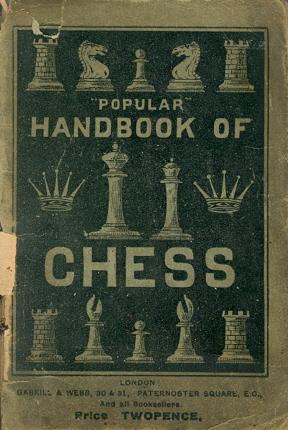
To enhance C.N.’s didactic value on-line, we bring together a number of extracts from a 31-page booklet, the “Popular” Handbook of Chess by Professor de Lyons Pike (London, circa 1902):
- ‘The rook (also called the castle) moves horizontally the entire length of the board, if the space is open.’ (Page 7)
- ‘Perpetual check is when the king can be placed in check at almost every move. When this is the case the weaker side can demand checkmate in any given number of moves. If his opponent fails to do this it can then pass as a drawn game.’ (Page 11)
- ‘Stalemate is when one of the players has nothing left but his king, which is so situated that he cannot move without placing himself in check.’ (Page 11)
- ‘When a player fails to cry “check” his adversary need not unless he likes move his king out of check, nor even cover him.’ (Page 13)
- ‘Drawn games count for nothing.’ (Page 13)
- ‘Castling often improves the situation when the game is crowded.’ (Page 15)
- The Allgaier Gambit: ‘It is not a safe opening, although, if successful, it will prove a strong one.’ (Page 25)
- ‘The Scotch Gambit; or Queen’s Pawn Two Opening ... besides having the two names given above, is also known as the Centre Gambit.’ (Page 29)
- ‘A great point to be observed in finishing a game, is, never to allow the king to escape into the centre of the board.’ (Page 31).
5644. Anti-Turton theme
C.N. 5350 gave this position from page 124 of Modern Chess Tactics by L. Pachman (London, 1970):
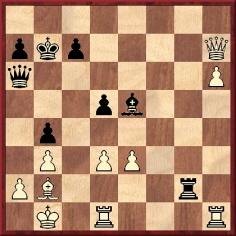
Lucarelli v Carra, Bologna, 1932. If 1 d4 then 1...Qe2. White therefore played 1 Rd2 Rxd2 2 d4 Qe2 3 Bc1, and Black resigned.
The full game-score has yet to be found, but is 1932 the correct year for the hunt? Michael Clapham (Ipswich, England) points out that when the position was discussed on pages 39-40 of The Chess Sacrifice by Vladimir Vuković (London, 1968) the date given was 1933.
5645. Sultan Khan
Further to our feature article on Sultan Khan, Steven Pla (Albuquerque, NM, USA) asks whether any of the master’s game-scores at ‘old chess’ (shatranj) are extant.
We recall none. It may be noted, though, that page 268 of The Encyclopedia of Chess Variants by David Pritchard (Godalming, 1994) gave the moves of a game of shatranj between Herbert Jacobs and George Thomas at the City of London Chess Club in 1914. Did either player contest games of shatranj against Sultan Khan during the latter’s brief period in Europe (1929-33)?
5646. Professor Hoffmann (C.N. 5620)
Regarding ‘Professor Hoffmann’ (Angelo John Lewis) some additional details have been received from Roger Mylward (Lower Heswall, England):
‘Census information suggests that he was born in London and lived in the capital until 1891 at least. The 1901 census has his residence as Sussex. He appears as Angelo John or Angelo J. in the 1841-1901 census returns.
He married Mary Ann Avery in 1864 in the Regent’s Park area of London. In 1881 he was living at 12 Crescent Place (off Brompton, near the Victoria and Albert Museum) in London with his wife and two children, Leonard A. Lewis (born 1867) and Maud A. Lewis (born 1868).’
5647. ‘Double-perpetual’
An extract from page 61 of The Pleasures of Chess by Assiac (New York, 1952):
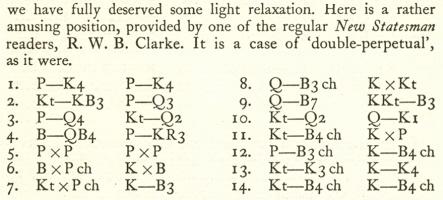
1 e4 e5 2 Nf3 d6 3 d4 Nd7 4 Bc4 h6 5 dxe5 dxe5 6 Bxf7+ Kxf7 7 Nxe5+ Kf6 8 Qf3+ Kxe5 9 Qf7 Ngf6 10 Nd2 Qe8 11 Nc4+ Kxe4 12 f3+

12...Kf5+ 13 Ne3+ Ke5 14 Nc4+ Kf5+ Drawn.
Wanted: further information about this game and other instances of the same theme.
5648. Kurt Richter
Alan McGowan (Waterloo, Canada) writes:
‘I am seeking a number of games of the German master Kurt Richter (1900-1969), and particularly from three Olympiads:
- Hamburg, 1930 (13-27 July): Richter-Voisin (France, round 4, 1-0); Richter-Thorvaldsson (Iceland, round 5, 0-1); Richter-Makarczyk (Poland, round 7, ½); Richter-O.M. Olsen (Norway, round 14, 1-0).
- Prague, 1931 (12-26 July): W. Michel-Richter (Switzerland, round 2, ½); Marín-Richter (Spain, round 3, ½); Richter-Hasenfuss (Latvia, round 7, ½); Becker-Richter (Austria, round 11, ½ – only the first nine moves have been found); Richter-Abramavicius (Lithuania, round 14, ½); Dake-Richter (United States, round 15, ½); Richter-Addicks (Holland, round 19, ½).
- Munich, 1936 (17 August-1 September): Pirc-Richter (Yugoslavia, round 3, ½); Richter-Sousa-Mendes (Brazil, round 8, ½); Foltys-Richter (Czechoslovakia, round 13, ½); Richter-Mikėnas (Lithuania, round 19, ½).
Sources already referred to: tournament books for all three Olympiads; the Olympiad games collections by Földeák and Gawlikowski; Deutsche Schachblätter; Deutsche Schachzeitung; Schach-Echo (relevant only for 1936); Wiener Schachzeitung; BCM; Magyar Sakkvilág (1930 only).
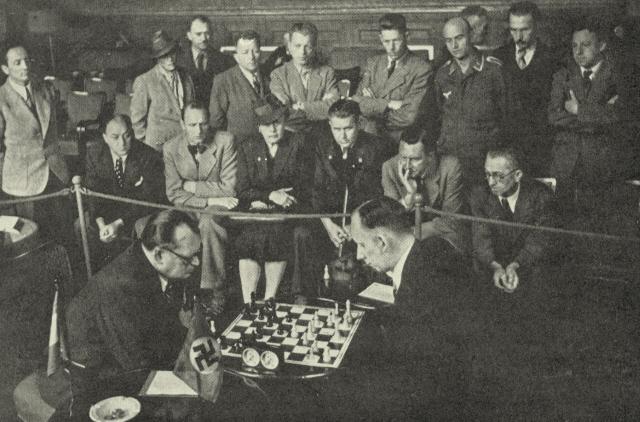
A. Alekhine v K. Richter, Munich, 1941. Source: page 71 of Alt om Skak by B. Nielsen (Odense, 1943)
Munich, 1942: Keres-Richter: I am interested in knowing the whereabouts of an original score of this game. Differences in the move-order have been seen in several sources: Kurt Richters Beste Partien (1961), ¡Legado! by Alekhine, Gran Ajedrez by Alekhine, the tournament book by Barcza and the Deutsche Schachzeitung. Tony Gillam’s book of the tournament (published in 2001) also drew on some of the above sources, as well as De Schaakwereld. The Deutsche Schachblätter, which had Richter as a member of the editorial board, published the score only from move 30 (1 November 1942 issue, pages 158-159).
It is known that after Richter’s death in 1969 many of his game-scores were sold. Does anyone know of a collector who possesses Keres-Richter?
I am also seeking games played by Richter in his later years. He was still participating in club tournaments and team competitions in the Berlin League, and he played in the Open Berlin Championships (East) of 1962 and 1963.
The latest game that I have is a win against Olaf Thal in a team competition in 1962 (0-1, 30).’
5649. FIDE championship (C.N. 4056)
C.N. 4056 quoted from an article by Kasparov on pages 104-105 of the 8/2005 New in Chess:
‘Botvinnik first captured the highest title in 1948, in the first true world championship event organized under FIDE – discounting their earlier amateur titles that were given little significance by contemporaries and even less by history. Prior to World War II FIDE failed to interest the champions, Alekhine publicly scoffing at Bogoljubow’s FIDE title.’
We asked, without result, where Alekhine scoffed.
Now, some comments by Alekhine on the subject can be quoted, from page 24 of volume one of A.J. Gillam’s production, Argentinian Scrapbook of Chess Columns (Nottingham, 1992). In a lengthy article in the newspaper La Nación (issue undated, but the article was headed ‘Paris, June 1928’) Alekhine discussed that year’s match between Bogoljubow and Euwe. His remarks included the following (in our translation from the Spanish):
‘However, the interest aroused by the match, virtually everywhere, is not limited to the purely chess-related side. Of no less importance would seem to be its sporting consequences, because of a decision by the FIDE (International Chess Federation) office, which decreed, when the match began, that the winner would be proclaimed FIDE champion.
I have no personal interest in the question of that title and can therefore, with all the more sincerity, express my astonishment not at the creation of the title, which, in short, can harm nobody, and can, rather, enhance the slightly compromised prestige of the organization introducing it; yet in truth we cannot pass over in silence the form chosen for disputing the title.
Why was Euwe chosen, when he has not had a single real success in international tournaments worthy of that name, and why was consideration not given to Nimzowitsch, Vidmar, Rubinstein, Tartakower, Réti, Marshall, Spielmann and tutti quanti? Is the sole reason the fact that the President of FIDE is of the same nationality as the opponent chosen for Bogoljubow? Certainly I would not wish to believe so ... But the FIDE office should not forget that after its series of gaffes following the recent world championship it needs to be particularly prudent, so as to avoid compromising in a definitive manner, before the entire world, the institution that it represents.’
See the feature article ‘FIDE Championship (1928)’.
5650. Favourite games
Following on from our articles in June 2008 about players’ choices of their best games, Peter Morris (Kallista, Victoria, Australia) notes that ‘favourite games’ were presented on pages 226-281 of Chess Treasury of the Air by Terence Tiller (Harmondsworth, 1966):
- G. Abrahams: Abrahams v Spencer, Liverpool (?), 1930.
- C.H.O’D. Alexander: Tylor v Alexander, Hastings, 4 January 1938.
- L. Barden: Barden v W. Adams, Hastings, 1950-51.
- R.J. Broadbent: Fichtl v Broadbent, Anglo-Czech Match, London, 14 June 1947.
- Rowena Bruce: Rowena Bruce v Ronald Bruce, Plymouth, circa 1958.
- P.H. Clarke: Larsen v Clarke, Hastings, 3 January 1957.
- M. Euwe: Euwe v Najdorf, Zurich, 13 September 1953.
- H. Golombek: Geller v Golombek, Budapest, 1952.
- M. Haygarth: Hamilton v Haygarth, ‘inter-county match’, 1956.
- C. Kottnauer: Kottnauer v Kotov, Prague, February 1946.
- E. Pritchard: Benini v Pritchard, Venice, May 1957.
- A. Sunnucks: Sunnucks v Mills, Bognor Regis, April 1960.
- R.G. Wade: Wade v Schmid, Sixth match game, Bamberg, 1950.
5651.
Identity parade
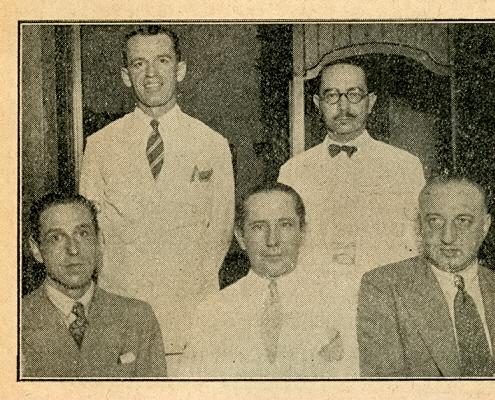
Which figure above is Octávio Trompowsky? For the solution, click here.
Source: El Ajedrez Americano, October 1933, page 263.
5652. Mildmay
Further to C.N. 5642 (on Scotland’s admission to FIDE), we seek information about Cav. Avv. dr. Henry Edward St John Mildmay, to use the full name from page 17 of the FIDE Livre d’or published by CHESS, Sutton Coldfield in 1977. His birth and death dates were specified as 18 July 1877 and 4 December 1944, and the book listed him as an administrateur adjoint of the Federation from 1927 to 1944. For a photograph of him, see C.N. 4363. Although British, he represented Italy within FIDE (for reasons we have yet to ascertain), and various editions of FIDE’s minutes in the 1920s and 1930s gave his address as 18 Via Santa Maria Fulcorina, Milan 8.
In Storia degli Scacchi in Italia by A. Chicco and A. Rosino (Venice, 1990) he was mentioned only once, in a footnote on page 316 which recorded his equal fifth place among seven players in a lightning tournament (Venice, September 1929) won by Alekhine.
5653. Hatton-Ward
Was W. Hatton-Ward’s forename William or Walter? The former was given in the index to Kings, Commoners and Knaves, whereas the index to the English edition of Pablo Morán’s book on Alekhine had the latter. Trying to double-check the correct name, we can currently find no more than the initial W. in contemporary sources, which also vary as to whether his surname was hyphenated.
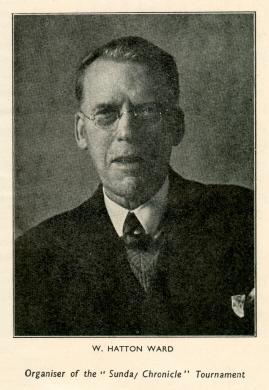
From the London, 1946 tournament book published by CHESS, Sutton Coldfield
Addition on 3 June 2021:
Walter Hatton Ward (see C.N. 11869).
5654. FIDE championship (C.N. 5649)
Christian Sánchez (Rosario, Argentina) reports that Alekhine’s article appeared on page 3 of section 2 of La Nación, 1 July 1928.
5655. Aristotle (C.N. 4005)
C.N. 4005, an item entitled ‘Pre-chess chess quotes’ gave the following from page 5 of Chess Quotations from the Masters by H. Hunvald (Mount Vernon, 1972):
‘When you are lonely, when you feel yourself an alien in the world, play chess. This will raise your spirits and be your counselor in war. – Aristotle.’
Michael Clapham (Ipswich, England) draws attention to this passage on page 219 of A History of Chess by H.J.R. Murray (Oxford, 1913):
‘From the time of al-Ma’mūn onwards, the writings of the more famous Greek philosophers became known to the Muslim world in translation. It was, perhaps, inevitable that the scattered allusions to the Greek board-games which occur in Plato and other writers should be misapplied to chess, but to this we owe the statements in H and later chess books that Aristotle, Galen and Hippocrates were also chessplayers.’
Page 175 gave the meaning of ‘H’: ‘MS John Rylands Library, Manchester, Arab. 59.’
A further extract from Murray’s book (page 164):
‘Greek literature and tradition are alike silent as to the existence or otherwise of these works and theories, and when we turn to the Arabic chess MSS which are based upon the works of al-‘Adlī and aṣ-Ṣūlī, we find the only references to Greek chess relate to the philosophers Hippocrates and Galen, and to Aristotle.’
5656. Who? (C.N. 5635)
C.N. 5635 asked who wrote the following:
‘I have played against the following noted players, winning the first game that I contested with each master, namely: Zukertort, Steinitz, Lasker, Pillsbury and Max Weiss.’
The answer is Walter Penn Shipley, in a letter on page 169 of Chess Review, October 1941.
He died a few months afterwards, on 17 February 1942. Under three weeks later came the death of his close friend Capablanca, whose obituary on page 30 of the March-April 1942 American Chess Bulletin was accompanied by a small photograph of them together. It was taken at the Union League Club, Philadelphia on 21 March 1938, and a fine print was included in Walter Penn Shipley Philadelphia’s Friend of Chess by John S. Hilbert (Jefferson, 2003), courtesy of Shipley’s grand-daughter, Nancy Shipley Rhoads. We are grateful to Dr Hilbert for permission to reproduce it here:
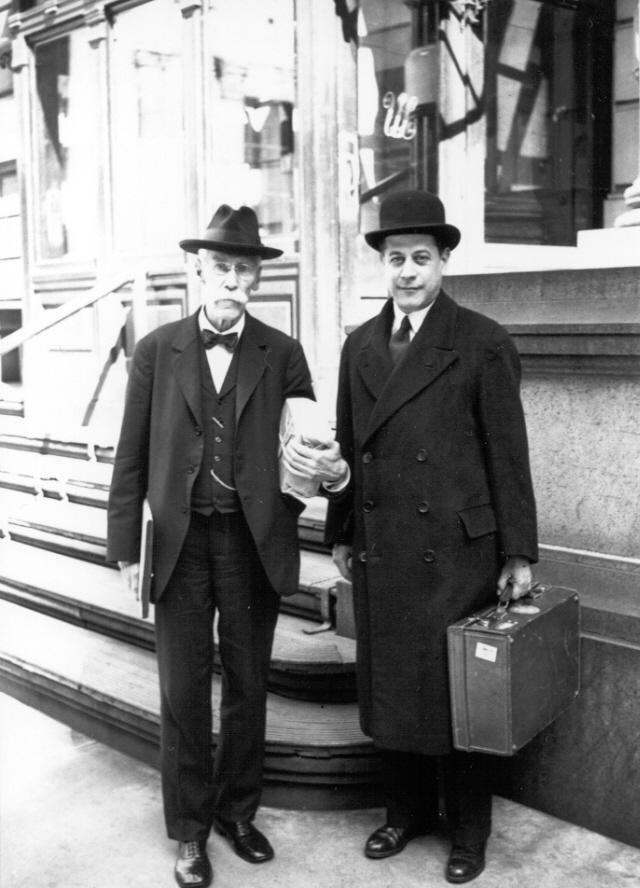
5657. Seconds
Milan Ninchich (Macquarie, ACT, Australia) asks whether a list exists of the seconds of all the men’s and women’s world champions.
5658. ‘Philip Robar’
Further to our article An Indian Copying Mystery, Tony French (Worthing, England) mentions another volume published by Pankaj Books which gives Philip Robar as its author: Important End Games in Chess (Delhi, 2002). Mr French points out that the contents are taken from various sources, including R. Bott and S. Morrison’s Discovering Chess and A.J. Gillam’s Simple Checkmates.
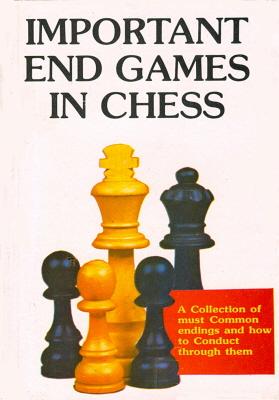
On the front cover the book commends itself thus:
‘A Collection of must Common endings and how to Conduct through them.’
5659. Flohr v whom?
Jan Kalendovský (Brno, Czech Republic) submits this photograph:
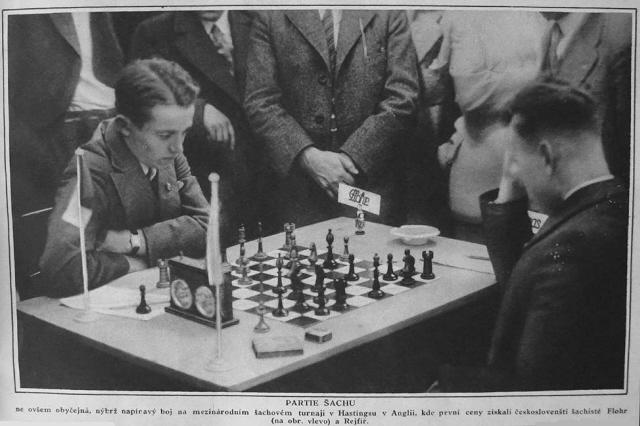
For a larger version, click here.The caption is misleading, but can readers identify Black? It is possible to do so without consulting a games database.
5660. Claims by Fine
Our article on Sidney Bernstein related Reuben Fine’s claim on page xviii of Lessons from My Games (New York, 1958) that ‘Bogoljubow had some of his rivals put in concentration camps by the Nazis when they arrived on the scene in Germany’. Pressed to identify these rivals, Fine gave the name of one person, Seitz (who was not in Europe during the Second World War).
We add here that Fine made a slightly different allegation on page 211 of The World’s Great Chess Games (New York, 1951), when Bogoljubow was still alive:
‘In Nazi Germany a famous grandmaster tried to force his journalistic rivals into concentration camps to get their columns away.’
5661. British Library
Would any reader be able to verify for us a specific (relatively straightforward) matter in the newspaper collection at the British Library, Colindale Avenue, London?
5662. ‘Outrageously libellous’
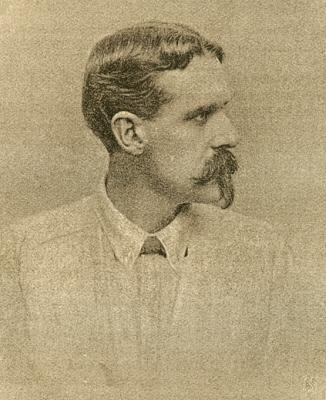
This photograph of Wordsworth Donisthorpe (1847-1914) was published on page 97 of the December 1890 Chess Monthly, and the following page had a biographical note on his chess career and non-chess writings. Page 255 of Kings, Commoners and Knaves quoted briefly from a poem (‘British Chess Club Alphabet’) ascribed to Donisthorpe on pages 138-139 of the January 1895 Chess Monthly, and below is the full text given by the magazine:

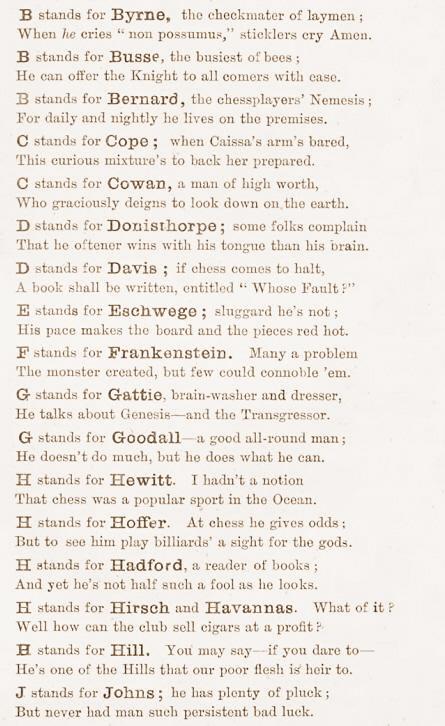

As mentioned in our earlier item, the brief feature below appeared on page 127 of the March 1925 BCM:
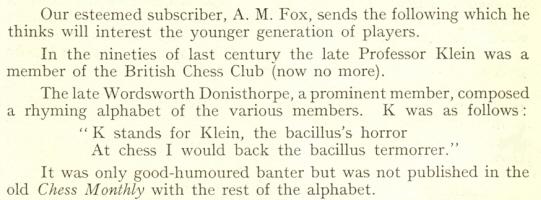
A.M. Fox returned to the subject in an article ‘Reminiscences of the British Chess Club’ on pages 34-35 of the February 1941 BCM, stating that Klein was ‘a bacteriologist at St Bartholomew’s Hospital’ and ‘quite a good player’. The couplet on Reeves was explained as follows:
‘Mr H.A. Reeves was by profession a surgeon with a large clientele among ladies, and he was known in the chess world by his insistence that the move P-KB4, as the fourth [sic – third] move in the Ruy López, was the best defence.’
5663. San Sebastián, 1911 (C.N.s 4447, 4469 & 4549)
From Miquel Artigas (Sabadell, Spain):
‘I recently acquired two photographs from the San Sebastián, 1911 tournament, on which the photographer is indicated as “B. Resines. San Sebastián”. They are slightly damaged and sun-faded, and a previous owner has written various players’ names underneath. One of the shots is well known and was discussed in C.N.s 4447, 4469 and 4549, but I had never seen the second one before. This is another example of a topic discussed in C.N. 5372 (similar photographs).’
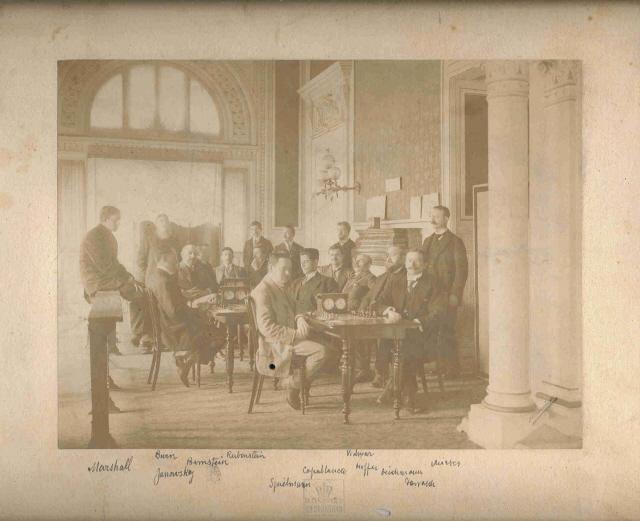
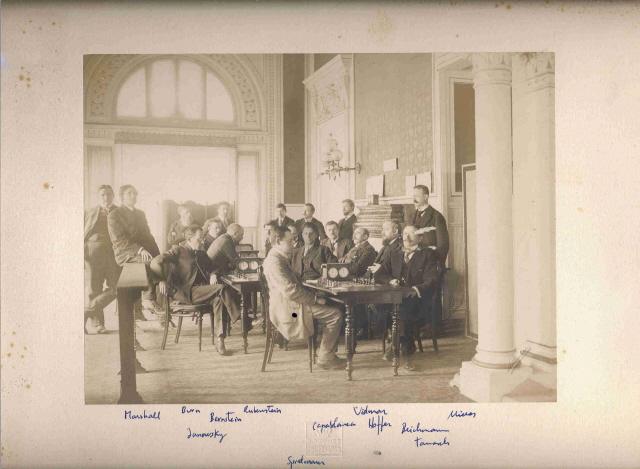
For a larger version of the second photograph, click here.
5664. Marshall’s Gambit
From page 135 of The Greatest Ever chess opening ideas by Christoph Scheerer (London, 2008):
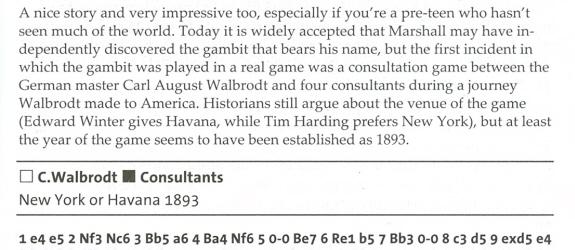
We are aware of no ‘argument’ about the venue of the
Walbrodt game, which was given in C.N. 1996 (see page
151 of Kings, Commoners and Knaves). He played
the game in Havana on 18 or 19 February 1893 against
four Cuban amateurs: Enrique Conill, Enrique Ostolaza,
López and Herrera. In another encounter involving the
same players Walbrodt was Black.
As shown below, the ‘Marshall’s Gambit’ game was published on pages 22-23 of the February 1893 issue of The Chess World (a magazine based in Washington, DC) and on pages 120-121 of Deutsches Wochenschach, 2 April 1893:

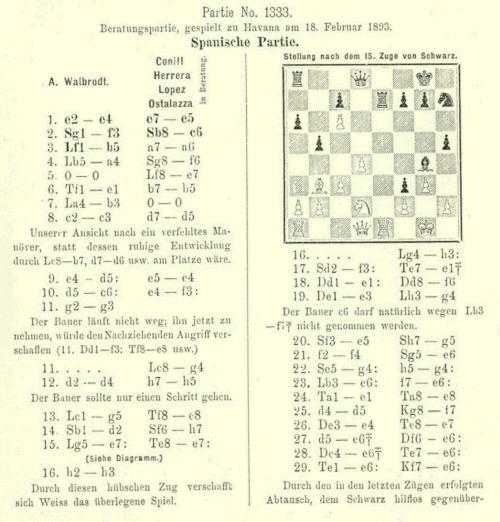
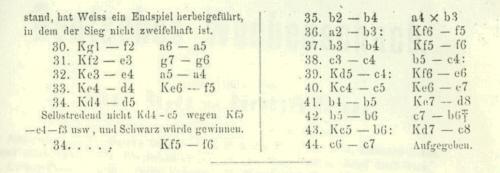
The Deutsche Schachzeitung (pages 110-111 of the April 1893 issue) gave only the game in which the Allies had the white pieces:
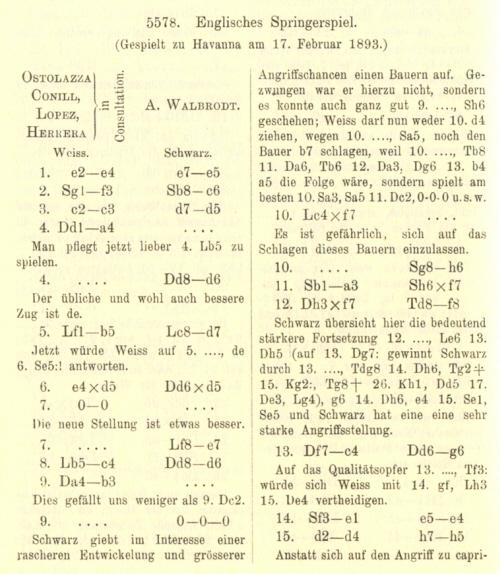
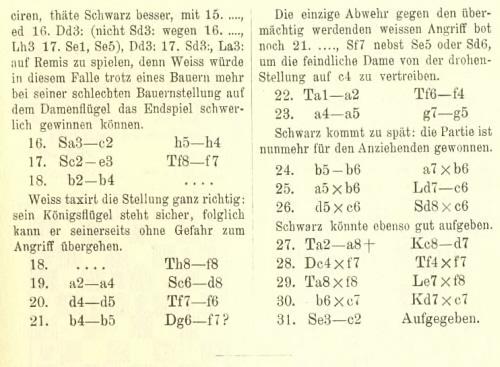
We believe that the German magazines’ spellings of the name Ostolaza were incorrect. See page 23 of Ajedrez en Cuba by Carlos A. Palacio (Havana, 1960).
5665. Predictions (C.N.s 4648, 5116, 5117 & 5538)
Concerning predictions as to the outcome of the 1927 world championship match we have come across the view of Réti as published on page 12 of the Argentinian newspaper La Nación of 14 September 1927 and quoted on page 209 of volume one of Historia del ajedrez argentino by José A. Copié (Buenos Aires, 2007):
‘To assert, as does Maróczy, that victory is bound to go to Capablanca ... is to act as a fortune-teller. There will be reasons for saying that Capablanca is an exceptional master in our field, in that his career has no failures of any kind, yet if we make a thorough study of the characteristics of each player, if we consider the psychological factors that will come into play in the match and if, more importantly, we destroy the legend of Capablanca’s invulnerability – which has become a reality among aficionados – we shall conclude that there are no fundamental reasons for affirming with such certainty that the Cuban grandmaster must necessarily defeat the talented Slav player.’
‘Capablanca has an apathetic temperament, he does not have further ambitions and he is incapable of preparing himself intensely for a match of this kind, since it is annoying for him to have to think. By dint of his natural talent he has arrived where he is, but he does not love chess. He is admirably instinctive but lacks the energy to undertake strict training.
Alekhine, in contrast, has an extraordinary wealth of energy. When engaged in battle, he is driven by noble eagerness to excel himself, and he has subjected himself to training commensurate with the importance of the match to be played ...’
Christian Sánchez (Rosario, Argentina) has provided the complete text of the newspaper item, in which Roberto Grau reported comments made to him by Réti in London that summer.

5666. Stray J.
Page 46 of Roberto Grau, el maestro by G.C. Grau, J.R. Delfino and J. Morgado (Buenos Aires, 2007) has a quote from La Nación in 1935 which refers to ‘R.J. Fine’. C.N. 94 mentioned a reference to ‘Edward J. Lasker’, and C.N. 4916 discussed occurrences of ‘Samuel J. Reshevsky’.
5667. Similar photographs (C.N.s 5372 & 5663)
Pierre Bourget (Quebec, Canada) points out this pair of photographs of Alekhine and Bogoljubow, with Emanuel Lasker (Berlin, 1929):
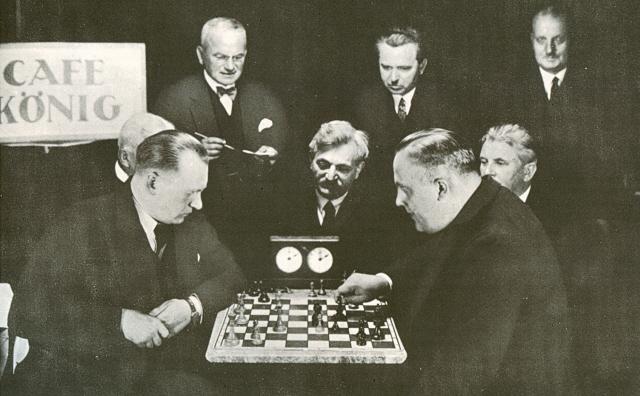
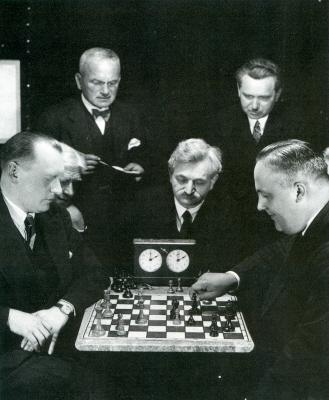
They were published respectively on page 75 of Umkämpfte Krone by R. Stolze (East Berlin, 1986) and page 51 of Schach 2000 Jahre Spiel-Geschichte by R. Finkenzeller, W. Ziehr and E.M. Bührer (Aarau, Stuttgart, 1989).
Can the other persons be named? The man standing on the left also appeared with Alekhine and Bogoljubow in a photograph on page 191 of Grandmasters of Chess by Harold C. Schonberg (Philadelphia and New York, 1972).
5668. Radom, 1943
Mr Bourget asks for information about an event mentioned on page 225 of Bogoljubow – The Fate of a Chess Player by S. Soloviov (Sofia, 2004):
‘Three months later in January 1943, the fourth “Governor’s Tournament” was played at Radom. The field was not so strong this time and Alekhine did not play. Bogoljubow won first prize convincingly.’
The final standings and Bogoljubow’s victory over Nowarra were published on page 42 of the April 1943 Deutsche Schachzeitung:
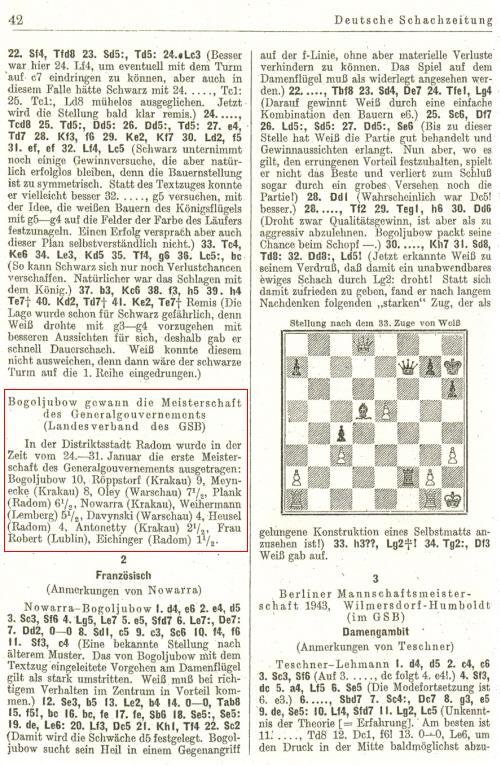
5669. Polugayevsky v Karpov
Alan O’Brien (Mitcham, England) notes that on page 2 of
Anatoly Karpov His road to the World Championship
by M. Botvinnik (Oxford, 1978) a mate in one was missed
in the notes to the first match game between
Polugayevsky and Karpov, Moscow, 1974:
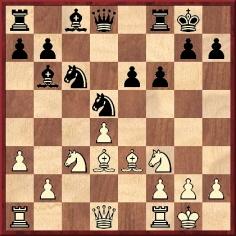

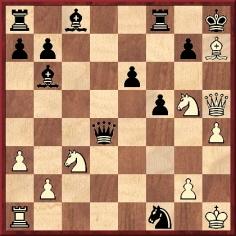
Position after 22 Kh1 (analysis by Botvinnik)
Rather than 22...Ng3+ Black has 22...Qg1 mate. We see that the error was already on page 17 of the Russian edition, Tri Matcha Anatolia Karpova (Moscow, 1975).
5670. Carl August Walbrodt
Walbrodt’s forename is given in various sources as either Carl or Karl, and we should like to find specimens of his signature. The illustration below comes from opposite page 290 of The Hastings Chess Tournament 1895 by H.C. Cheshire (London, 1896):

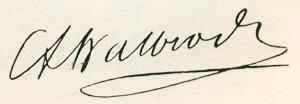
5671. Pollock on Steinitz v von Bardeleben
Our feature article on Steinitz v von Bardeleben, Hastings, 1895 contains this passage:
‘An account of how the game ended was, however, included in the annotations by W.H.K. Pollock, who had been a participant in the tournament, on pages 298-300 of La Stratégie, 15 October 1895. As it has not yet been established where the original English version appeared we quote the French translation after the move 25 Rxh7+:
“La partie a été terminée ici, M. de Bardeleben s’est retiré sans abandonner et la partie a été adjugée à M. Steinitz à l’expiration du temps limité. M. de Bardeleben a dit à son adversaire que sa conduite était pour protester contre les applaudissements souvent trop prolongés dont les visiteurs saluaient les victorieux et c’est à la suite de cet incident que le Comité du tournoi a défendu toute démonstration.”
In short, von Bardeleben left the hall without resigning and allowed his time to run out because of the disturbance caused by spectators applauding winners of games, and he informed Steinitz personally of this.’
Now, Joost van Winsen (Silvolde, the Netherlands) has found the following note by Pollock, after White’s 25th move, in the Baltimore News:
‘Bardeleben here retired and lost the game on the time limit. Subsequently he explained to his opponent that his action was meant as a protest against applauding a victor. Hence the notice of the committee described above.’
Pollock’s description of the notice read as follows:
‘At the beginning of the third week’s play the following notice was posted: “Visitors are requested to refrain from applause on the conclusion of any game, as such demonstrations are most obnoxious to the masters and are contrary to the wish of the committee.” This stopped the applause, which, it must be said, had been frequently quite prolonged and irrepressible, which arose quite spontaneously, and which was evidently more objected to by the modest winners than the losers. Here it should be stated emphatically that the constant efforts of the committee to secure comfort to both players and spectators have been attended with great success. Reserved seats close around any board are sold at 2s.6d. a day.’
The report by Pollock in the Baltimore News was dated 21 August 1895, but the exact date of the newspaper is not available. Our correspondent found the item on page 126 of a scrapbook of Baltimore News cuttings held by the Cleveland Library.
5672. Errata list by David Lawson
In a letter dated 11 June 1979 David Lawson sent us ‘a short list of errata for [Paul Morphy The Pride and Sorrow of Chess], as I understand that many copies of the book went out without it’:
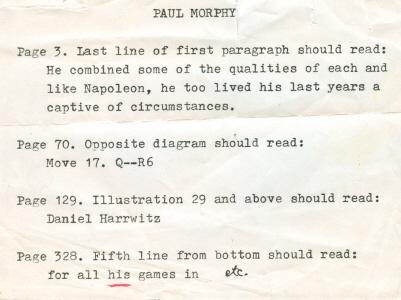
5673. Chéron postcard
Philippe Kesmaecker (Maintenon, France) draws attention to a postcard, owned by Roger Chesnel, in which André Chéron discussed the game Důras-Capablanca, New York, 1913:
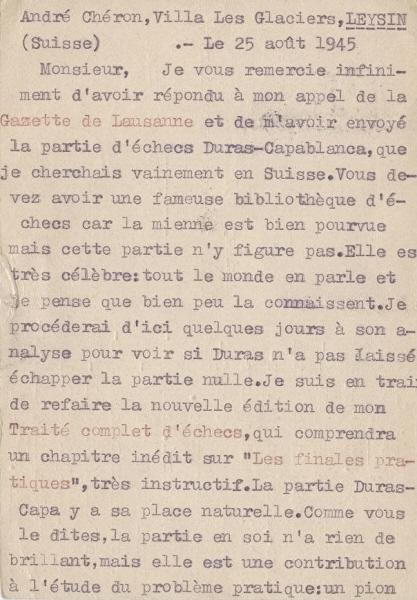
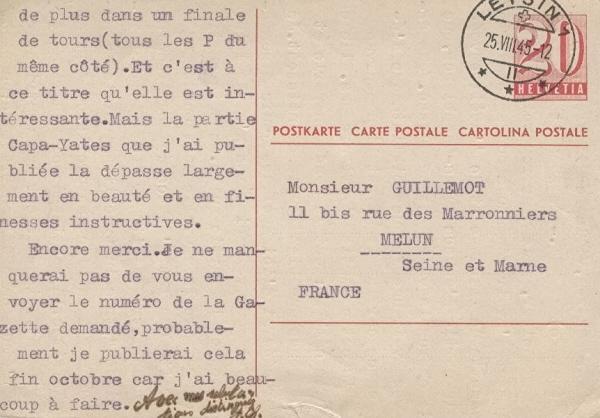
It seems strange that Chéron had appealed in the Gazette de Lausanne for what was, even then, a readily accessible game-score. Quite apart from contemporary magazines, it appeared in the Schachjahrbuch für 1913 and The Year-Book of Chess 1914.
Our collection includes a copy of Capablanca’s score-sheet. The times are indicated as five hours for White and two hours 55 minutes for Black.
5674. Golombek
C.N. 3255 (see page 249 of Chess Facts and Fables) mentioned a reference to ‘Sir Henry’ Golombek on page 40 of The Sporting Scene by George Steiner (London, 1973). Below are some references to ‘Sir’ Harry Golombek in US sources:
- Chess Digest, February 1971, page 34.
- Chess Digest, July 1971, page 164.
- The World Chess Championship A History by Al Horowitz (New York, 1973), page 286.
- The Chess of Bobby Fischer by Robert E. Burger (Radnor, 1975), page 370.
Golombek, of course, was never knighted. He was merely given the OBE for services to chess, in 1966.
5675. Petrosian’s Legacy
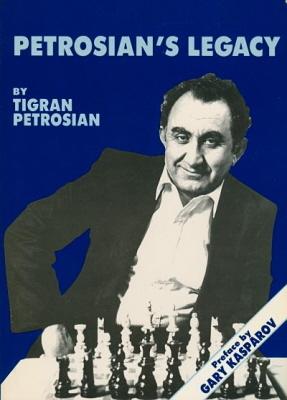
Tim Bogan (Chicago, IL, USA) writes: ‘I very much like Petrosian’s Legacy (Los Angeles, 1990) and wish it had been properly edited.’ He quotes these extracts:
- ‘I am especially grateful to Grandmaster Arnold Denker for his tremendous effort in editing an otherwise “Russian” English text to make it acceptable; without his great contribution this book would have no moral rights of being published in English.’ (From Rona Petrosian’s acknowledgements)
- Page ii: ‘Petrosian is a master of the art of creating harmonious, and vivid chess positions, which on occasion lacked an open-to-eye dynamics.’
- Page 6: ‘White’s centralized army develops an utmost energy.’
- Page 28: ‘The queen looks where to get employed.’
- Page 48: ‘Alas! they had no more time to beauties like 24...cxb 25 cxd Bxd3 26 dxe.’
- Page 64: ‘One should not be an outstanding combinative player for discovering this piece “sacrifice”.’
- Page 103: ‘If 43...Nd7 (a passive behold) ...’
5676. Flohr v whom? (C.N. 5659)

The Czech caption to this photograph states:
‘A game of chess
Though not a commonplace one but an exciting battle in the international chess tournament at Hastings in England, where the first prizes were won by the Czechoslovak chessplayers Flohr (on the left of the picture) and Rejfíř.’
In reality, the photograph was taken at the Prague, 1931 Olympiad, and Flohr was in play against Mikėnas.
We reproduce another illustration from that event, published in the plates section of the tournament book:
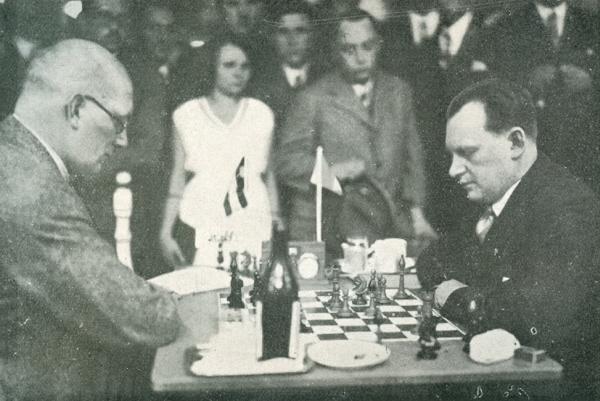
Ernst Grünfeld and
Alexander Alekhine (Prague, 1931)
5677. Walter Penn Shipley (C.N. 5656)
Nikolai Brunni (Honolulu, HI, USA) writes:
‘The statement by Walter Penn Shipley that he won the first game he contested against Zukertort, Steinitz, Lasker, Pillsbury and Weiss does not seem entirely true. In Lasker’s case, Shipley lost the first serious game between them. During a two-week engagement at the Franklin Chess Club in Philadelphia, Lasker played two games against each of five players (D.M. Martinez, A.K. Robinson, G.C. Reichhelm, H.G. Voigt and W.P. Shipley). According to The Collected Games of Emanuel Lasker by K. Whyld (Nottingham, 1998), their first game was played on 24 December 1892, Lasker winning on the black side of a Two Knights’ Defense; their second game, on 28 December 1892, was a Steinitz Gambit, won by Shipley as Black (see pages 43-44). The book then gave a further win by Shipley as Black with the same opening, but the source was merely specified as follows: “From Nepomuceno (Perhaps analysis of above.)” Page 45 had another victory by Shipley against the Steinitz Gambit, in a simultaneous display by Lasker on 2 January 1893. In all three Steinitz Gambit games the first ten moves were the same.’
5678. Quotes from the writings of Maróczy
Ignacio Raviolo (Rafaela, Argentina) asks whether the lesser-known writings of Géza Maróczy (i.e. mainly in Hungarian books) contain any particularly notable or quotable passages that deserve wider currency.
5679. Deliberately bad play
The section on Lasker in Réti’s Masters of the Chess Board (London, 1933) suggested that the former world champion ‘often deliberately plays badly’ (page 64). That claim is well known, but we wonder about this passage, regarding Réti himself, on page 173 of B.J. Horton’s Dictionary of Modern Chess (New York, 1959):
‘Réti viewed chess as a struggle between two personalities and as his biographer, Horace R. Bigelow, stated, Réti “often deliberately made bad moves, or inferior moves, if in his judgment these tended to lure his opponent to destruction”.’
5680. Prague, 1931 (C.N. 5676)
Zdeněk Závodný (Brno, Czech Republic) submits this photograph from the Prague, 1931 Olympiad:
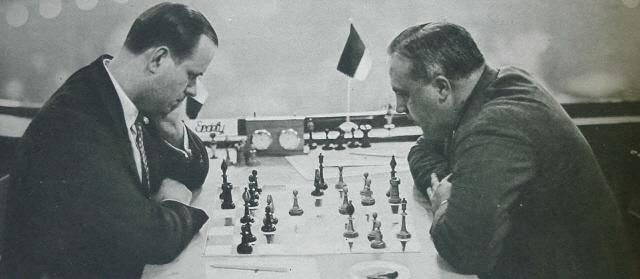
Ştefan Erdelyi and Efim Bogoljubow
Source: Letem světem, 21 July 1931.
5681. Byrne’s prediction on Fischer v Spassky (C.N. 2737)
The following appeared as C.N. 2737 (see page 205 of A Chess Omnibus):
An uncanny prediction by Robert Byrne on page 162 of the March 1972 CHESS:
“I believe Fischer will win. Would you like the score? 12½ to 8½! They will play 21 games.”
This was spot on, although Byrne’s next sentence was spot off:
“Fischer will be the world champion for the next 15 years.”
Alan O’Brien (Mitcham, England) now writes:
‘It sounds very good, but how much of a prediction is it? Byrne is simply saying that Fischer will win 4 games to 0, or 5-1, 6-2, 7-3 or any +4 score. The winning score of 12½ was not hard to fathom; only Botvinnik playing Tal had been ruthless enough to win the last game in a non-drawn title match since the War.’
Byrne was one of 26 respondents in the CHESS item on forecasts for the 1972 match. Many were non-committal, and the others were equally split as to whether the victor would be Spassky or Fischer. Only Byrne predicted a specific score. Three masters suggested in general terms that Fischer was certain to win: Donner, Mecking and Najdorf.
5682. Sämisch Variation (C.N.s 4974 & 4981)
We note an occurrence of the Sämisch Variation, by transposition, which predates the specimens discussed in C.N.s 4974 and 4981: a correspondence game between E. Voellmy and O. Procházka played in 1918-19 and published on pages 120-122 of the September-October 1919 Schweizerische Schachzeitung. It began 1 c4 e6 2 d4 Nf6 3 Nc3 Bb4 4 a3, and the full score can also be found on pages 26-28 of Erwin Voellmy by Paul Müller-Breil (Zurich, 2005).
5683. Slowest correspondence games (C.N.s 3435 & 3458)
Joost van Winsen (Silvolde, the Netherlands) quotes the following from Turf, Field and Farm, 4 June 1875:
‘We are indebted to Mr F.E. Brenzinger, of New York, for the subjoined game, together with the accompanying particulars of the match just concluded between that gentleman and his brother, Dr Karl Brenzinger, of Pforzheim, Baden.
Mr B. writes us as follows:
“I send you the last of five games played, by correspondence, between Dr Karl Brenzinger, of Pforzheim, Baden, and his brother F.E. Brenzinger, of New York. The games were begun in 1859, and the opening moves were published at that time by Mr Samuel Loyd in the New York Illustrated News, and also in the Musical World. Mr Loyd predicted that the match would probably be finished about the year 1870.
The first game was won in March 1866, by Dr B., only 24 moves having been made on each side; the second, which resulted in a mate on the 45th [sic] move, was also scored by the Doctor, in December 1869.
Mr F.E. B. won the third in April 1871, and also the fourth (which was published a few weeks ago) in March 1875.
The fifth and last was declared a draw in May 1875, thus leaving the score: Dr B. 2; Mr B. 2; Drawn 1.
In 1863 a contest of a similar character was commenced between Mr Albert Hug, of Mannheim, Baden, and Mr F.E. Brenzinger, of New York.
Five games were to be played, three of which are already finished (Mr B. 2, Mr H. 1), while two are still pending.”’
The same column gave this game-score:
Francis Eugene Brenzinger – Karl BrenzingerFifth match game, correspondence, 1859 – May 1875
Vienna Gambit
1 e4 e5 2 Bc4 Nc6 3 Nc3 Nf6 4 f4 Bc5 5 Nf3 Ng4 6 Bxf7+ Kf8 7 Rf1
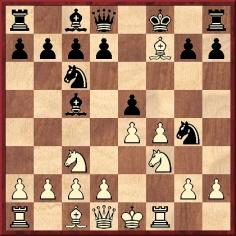
7...Nxh2 8 Qe2 Nxf1 9 Qxf1 Qf6 10 Bb3 Nd4 11 d3 Nxf3+ 12 Qxf3 Bb4 13 Bd2 Bxc3 14 bxc3 exf4 15 Bxf4 d6 16 Kd2 Ke7 17 e5 dxe5 18 Re1 Rf8 19 g3 Kd8 20 Qd5+ Qd6 21 Bg5+ Kd7 22 Qh1 h6 23 Be3 Kd8 24 Qe4 c6 25 Qa4 c5 26 Qe4 Kc7 27 Bd5 Bf5 28 Qc4 Rfd8 29 Bf3 Be6 30 Qe4 Bd5 31 Qxd5 Qxd5 32 Bxd5 Rxd5 33 c4 Rd6 34 Bxc5 Re6 35 d4 g6 36 d5 Ree8 37 Rf1 b6 38 Rf7+ Kd8
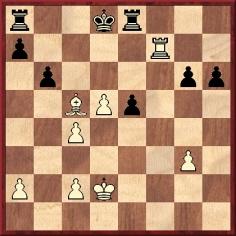
39 Rxa7 Rxa7 40 Bxb6+ Ke7 41 Bxa7 Rc8 42 c5 Ra8 43 Bb6 Rxa2 44 Kd3 Ra3+ 45 Ke4 Rxg3 46 Kxe5 Rg5+ 47 Kd4 Rg1 48 c4 Rb1 49 Bc7 h5 50 c6 h4 51 Bf4 Rd1+ 52 Kc5 h3 53 d6+ Kd8 54 d7 Rg1 55 Bd2 Rd1 Drawn.
Our correspondent notes that this game apparently lasted longer than the one given in C.N. 3435 (which finished in March 1875). He adds that the second game was published in the Spirit of the Times, 25 December 1869:
Karl Brenzinger – Francis Eugene BrenzingerSecond match game, correspondence, 1859 – December 1869
Evans Gambit Accepted
1 e4 e5 2 Nf3 Nc6 3 Bc4 Bc5 4 b4 Bxb4 5 c3 Bc5 6 O-O d6 7 d4 exd4 8 cxd4 Bb6 9 Bb2 Na5 10 e5 Nxc4 11 Qa4+ c6 12 Qxc4 d5 13 Qd3 Ne7 14 Nc3 Bf5 15 Qe3 h6 16 Nh4 O-O 17 Ne2 Be6 18 Ba3 Re8 19 f4 Nf5 20 Nxf5 Bxf5 21 h3 Re6 22 Ng3 Be4 23 Bd6

23...Bxg2 24 Kxg2 Qxd6 25 f5 Ree8 26 f6 g5 27 Rf5 Kh8
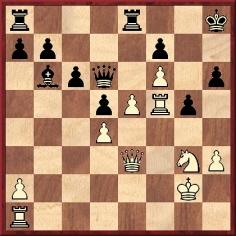
28 Rxg5 Qxf6 29 Rh5 Kh7 30 Rf1 Qg6 31 Rxf7+ Kg8 32 Rf4 Kh7 33 Rxh6+ Kxh6 and White mates in five moves.
5684. Mistrust
Page 382 of Kings, Commoners and Knaves quoted from page 79 of The Game of Chess by Siegbert Tarrasch (London, 1935):
‘Mistrust is the most necessary characteristic of the chess-player.’
It may be added that page 51 of a later (1994) English edition of Tarrasch’s book, edited by Lou Hays and David Sewell, had:
‘Mistrust is the necessary characteristic of a good chessplayer.’
Moreover, the original German edition (Berlin, 1931, page 110) was slightly different from both translations:
‘Mißtrauen ist eine der notwendigsten Charaktereigenschaften des Schachspielers.’ [‘Mistrust is one of the most necessary characteristics of the chess-player.’]
5685. Spot the differences
Philippe Kesmaecker (Maintenon, France) draws attention to this pair of group photographs of Carlsbad, 1907:
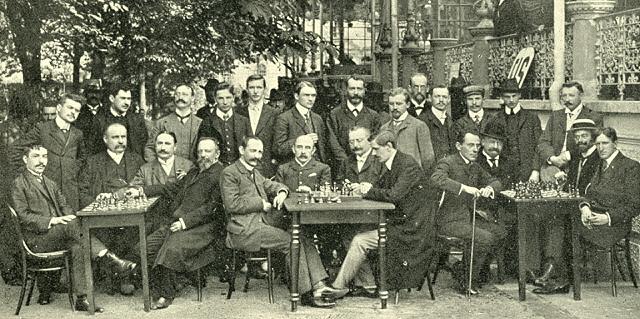

We shall revert to the matter shortly.
5686. Chigorin blindfold games
Graham Clayton (South Windsor, NSW, Australia) submits two games played by Chigorin in an eight-board blindfold exhibition at the Manhattan Chess Club and published on page 2 of the New York Times, 26 May 1889:
Mikhail Chigorin – B. HoffmanNew York, 25 May 1889
Evans Gambit Accepted
1 e4 e5 2 Nf3 Nc6 3 Bc4 Bc5 4 b4 Bxb4 5 c3 Ba5 6 O-O Nf6 7 d4 O-O 8 dxe5 Nxe4 9 Bd5 Nc5 10 Ng5 h6 11 Nxf7 Rxf7 12 Bxf7+ Kxf7 13 Qd5+ Ne6 14 f4 Bb6+ 15 Kh1 Ne7 16 Qf3 Kg8 17 f5 Ng5 18 Qh5 Ne4
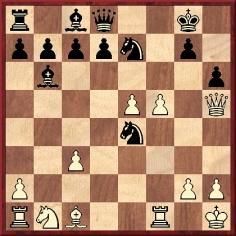
19 f6 Nf2+ 20 Rxf2 Bxf2 21 Bxh6 gxh6 22 Qxh6 Qf8 23 Qg5+ Ng6 24 Qxg6+ Kh8 25 Nd2 d5 26 Rf1 Be3
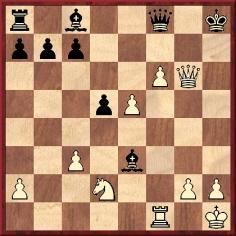
27 Rf3 Bxd2 28 g4 Qh6 29 Rh3 Resigns.
Mikhail Chigorin – Julius LivingstoneNew York, 25 May 1889
Danish Gambit
1 e4 e5 2 d4 exd4 3 c3 dxc3 4 Nxc3 Bb4 5 Nf3 Bxc3+ 6 bxc3 c6 7 Bc4 Ne7 8 Qd6 O-O 9 Bg5 Qa5
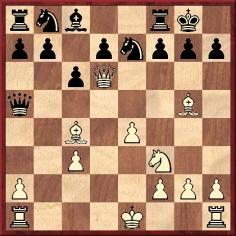
10 Bxe7 Qxc3+ 11 Nd2 Qxa1+ 12 Ke2 Qxh1 13 Bxf8 Qxg2 14 Qe7 d5 15 Qd8 Qg4+ 16 f3 Qd7 17 White resigns.
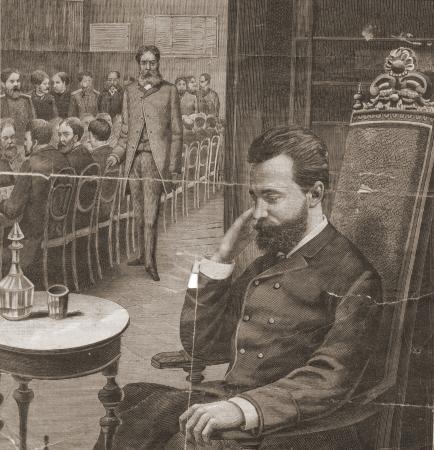
Mikhail Chigorin, Niva, 1888, page 444
5687. Lasker v Steinitz
From Ray Johnstone (Nedlands, WA, Australia):
‘Did Steinitz really lose on time in game six of his return match (1896-97) with Lasker, a loss rejected by Lasker? After 48 Kb2 Alex Dunne wrote on page 111 of 2010 Chess Oddities (Davenport, 2003):
“Steinitz exceeded the time limit at this point, but Lasker refused to win in this fashion and allowed Steinitz to play on.”’
Readers’ assistance in building up a digest of contemporary accounts will be appreciated. Here are two reports, the first of which corroborates the above quote:
‘48 Kc1-b2. Hier überschritt Steinitz die Bedenkzeit, Lasker proponirte aber Fortsetzung der Partie, und so wurde sie unter Zustimmung des Comités am nächsten Tage in folgender Weise zu Ende geführt.’
Source: Deutsche Schachzeitung, January 1897, page 10.
In contrast, page 8 of the 15 January 1897 issue of La Stratégie stated that the game was adjourned after 47...Rc8 and that the following day Steinitz was indisposed and did not appear. Instead of forfeiting Steinitz, the Committee allowed him to continue play the next day but one:
‘La partie a été ajournée ici et le lendemain M. Steinitz, malade, ne s’est pas présenté pour la continuer. Le Comité au lieu de lui compter la partie perdue l’a autorisé à la finir le surlendemain ...’
5688. What?
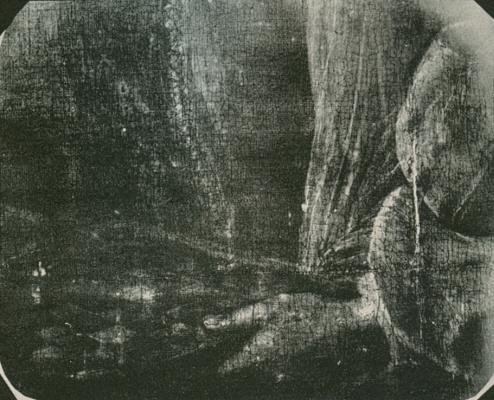
| First column | << previous | Archives [48] | next >> | Current column |
Copyright: Edward Winter. All rights reserved.